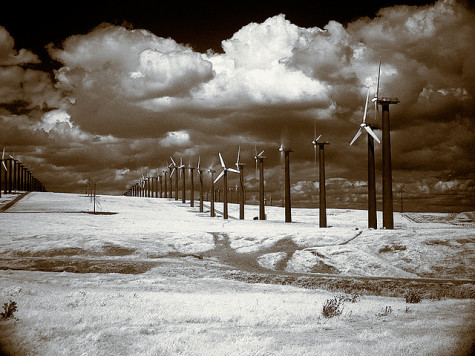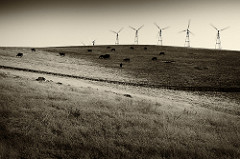 When I was six I had my very own windmill. At least that’s what my dad told me. We were driving to camp through Altamont Pass, which held one of the first wind farms in the country. He squinted up at the golden hills and pointed. “There,” he said. “That’s the one.”
When I was six I had my very own windmill. At least that’s what my dad told me. We were driving to camp through Altamont Pass, which held one of the first wind farms in the country. He squinted up at the golden hills and pointed. “There,” he said. “That’s the one.”
Later, he explained that he’d bought some stock in the company that owned the wind farm, which required more explanation still. But I did understand that while there probably wasn’t a single windmill with my name on it, that somehow, we were tied to those things that spun around in the wind.
At the time windmills seemed like the perfect solution. The wind was there all the time, why not stick something up there to make use of it? But every year when we passed through, it seemed like some of them weren’t spinning. My favorite ones—the ones I would pick if I really could own one—looked like eggbeaters. Then one year we drove up the hill, past the enormous cross mowed into the hillside, and there were bare spots where the eggbeaters used to be.
These windmills and their design started to age, even though the wind kept blowing. (The vertical-axis ones I loved, for example, weren’t as efficient as their more traditional-looking counterparts on the pass.)
Then there were the birds. According to the Audubon Society, at the time no one really realized what a bad combination birds and blades could be. But later research showed that the area is prime habitat for protected golden eagles and many other species—and that several thousand birds die each year among the windmills, including 75 to 110 golden eagles annually.
Last month, researchers published a method that they hope could help planners find sites for future wind farms that might avoid so many fatalities. Looking at the state of Wyoming, they collected data from known golden eagle nesting sites and incorporated other environmental factors that influence nest sites, like availability of prey and the topography the eagles preferred to predict likely nesting sites. The researchers then overlaid this with maps of areas where wind is a resource, which could help predict risk to eagles from future turbine sites.
The windmills have already staked their claim on the land, but some companies are starting to replace outdated turbines with newer technology aimed to boost power and reduce bird deaths.
Windmills remain controversial; during the replacement of 438 of the older windmills with 50 newer models, vandalism delayed the project. An ill wind seems to be blowing around another set of turbines, too, with a series of permitting appeals and reversals making the arrival of safer, speedier windmills uncertain. A new investment from Google may help; in February, the company announced that it would buy enough power from the turbines here to support its Mountain View campus, about 50 miles to the south and west. The deal involves retiring 370 old turbines and replacing them with 24 new ones.
We still drive through the pass every year on the way to camp, and my boys look out at the windmills. This summer, I told them one of them used to be mine. “Which one?” they asked.
At first, I point to one on the crest of the hill. But then I tell them it’s complicated; I’m not sure how I feel about the windmills right now. So instead, I ask them which one they’d have, if they could pick. They spend the next few minutes debating which turbine they’d like the best, until we come down the far side of the pass, and they move on to what lies ahead.
**
Images of Altamont Pass by Dave Le and Daniel from Sacramento via Flickr/Creative Commons license